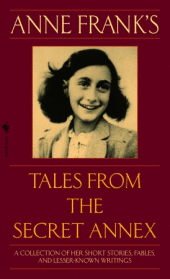Anneliese Marie Frank
A victim of the Holocaust

"The story of Anne Frank is among the most well-known of the six million Jews who died in the Holocaust. Her diary is the first encounter many people have with the history of Nazi Germany's attempt to murder all the Jews of Europe during World War II."
Holocaust EncyclopediaBiography
menu
She was born Annelies Marie Frank on June 12, 1929, in Frankfurt am Main, Germany. Her parents were Otto and Edith Frank. For the first 5 years of her life, Anne lived with her parents and older sister, Margot, in an apartment on the outskirts of Frankfurt.
Unemployment was high and poverty was severe in Germany, and it was the period in which Adolf Hitler and his party were gaining more and more supporters. After the Nazis came to power in 1933, Otto Frank fled to Amsterdam in the Netherlands, where he had business connections. The rest of the Frank family soon followed, with Anne being the last of the family to arrive in February 1934 after staying with her grandparents in Aachen. She learned the language, made new friends and went to a Dutch school near her home. Her father worked hard to get his business off the ground, but it was not easy. Otto also tried to set up a company in England, but the plan fell through. Things looked up when he started selling herbs and spices in addition to the pectin.
On 1 September 1939, when Anne was 10 years old, Nazi Germany invaded Poland, and so the Second World War began. Not long after, on 10 May 1940, the Nazis also invaded the Netherlands. Five days later, the Dutch army surrendered. Slowly but surely, the Nazis introduced more and more laws and regulations that made the lives of Jews more difficult.
In 1941, after German forces occupied the Netherlands, Anne was compelled to transfer from a public school to a Jewish one. On June 12, 1942, she received a red-and-white plaid diary for her 13th birthday. That day she began writing in the book:
“I hope I will be able to confide everything to you, as I have never been able to confide in anyone, and I hope you will be a great source of comfort and support.”
When Margot received a call-up to report for a so-called "labour camp" in Nazi Germany on 5 July 1942, her parents were suspicious. They did not believe the call-up was about work and decided to go into hiding the next day in order to escape persecution. The Franks went into hiding on July 6, 1942, in the backroom office and warehouse of Otto Frank’s food-products business. With the aid of a few non-Jewish friends, among them Miep Gies, who smuggled in food and other supplies, the Frank family and four other Jews — Hermann and Auguste van Pels and their son, Peter, and Fritz Pfeffer — lived confined to the “secret annex.”
During the two years in hiding, Anne wrote about events in the Secret Annex, but also about her feelings and thoughts. In addition, she wrote short stories, started on a novel and copied passages from the books she read in her Book of Beautiful Sentences. Writing helped her pass the time. Anne’s last diary entry was written on August 1, 1944.
Anne started rewriting her diary, but before she was done, she and the other people in hiding were discovered and arrested by police officers on 4 August 1944. The police also arrested two of the helpers. To this day, it is not known the reason for the police raid.
The Frank family was transported to Westerbork, a transit camp in the Netherlands, and from there to Auschwitz, in German-occupied Poland, on September 3, 1944, on the last transport to leave Westerbork for Auschwitz. Anne and Margot were transferred to Bergen-Belsen the following month.
Anne’s mother died in early January, just before the evacuation of Auschwitz on January 18, 1945. It was established by the Dutch government that both Anne and Margot died in a typhus epidemic in March 1945, only weeks before the liberation of Bergen-Belsen, but scholars in 2015 revealed new research, including analysis of archival data and first-person accounts, indicating that the sisters might have perished in February 1945. Otto Frank was found hospitalized at Auschwitz when it was liberated by Soviet troops on January 27, 1945.
Otto was presented later with Anne’s writings, which were preserved by Miep Gies one of the Dutch citizens who had hidden the Franks. Otto Frank was integral to getting his daughter’s diary published. The book was later translated into around 70 languages and adapted for stage and screen. People all over the world were introduced to Anne's story and in 1960 the hiding place became a museum: the Anne Frank House.
Museum
menu
The Anne Frank House is a museum with a story. As a visitor, you experience this story through quotes, photos, videos, and original items. The atmosphere in the museum is authentic and subdued. For visitation rules and information please visit: Anne Frank Musem website.
"Thanks to Father, who had brought my whole collection of picture postcards and movie stars here beforehand, I have been able to treat the walls with a pot of glue and a brush and so turn the entire room into one big picture."
Anne Frank, 11 July 1942









